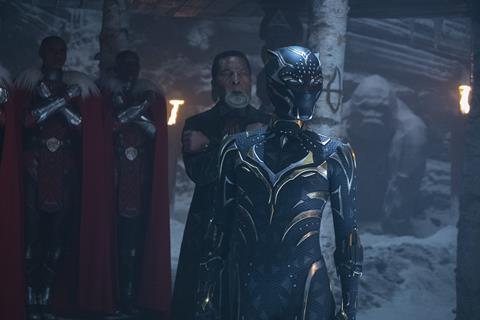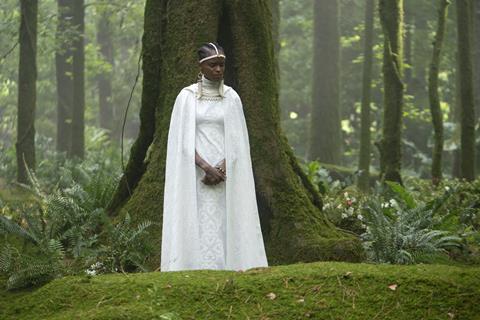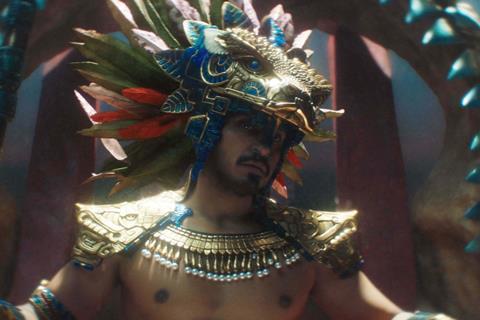Following her Oscar-winning work on Black Panther, costume designer Ruth E Carter tells Amber Wilkinson how her designs for the sequel honour its departed lead character while expanding the film’s world.

Costume designer Ruth E Carter has taken on many challenges in more than three decades as a department head, but few come as ambitious as Black Panther: Wakanda Forever, covering multiple worlds each with their own distinctive look.
The sequel to 2018’s Black Panther — for which Carter became the first African American to win the Oscar for best costume design — takes audiences back to Wakanda, while also paying a visit to the US and introducing the underwater realm of the Talokanil.
“The opportunity for me — as an artist, as a costume designer, as a person who cares about cultures — was enormous because I was not chained to a fad or a trend or fashion in any way,” says Carter. “It was an opportunity to be creative and be in an artistic medium of several types, whether it be clay sculpting or 3D printing, using technology to create a new culture that’s fictitious, underwater, as well as to elevate what we had from the first movie and bring Wakanda up to date.”
Ryan Coogler’s film sees Wakanda in mourning after the death of King T’Challa (Chadwick Boseman, who died in 2020). As Queen Ramonda (Angela Bassett) and her daughter Shuri (Letitia Wright) struggle with the loss, they find their country facing a new threat from the underwater nation of Talokan and its proud leader Namor (Tenoch Huerta Mejia).
Wakanda Forever is not just a collaboration with Coogler, says Carter, but also a partnership with the cast: “They come into my fitting room and I try to make it a playground.” The costume designer also collaborated with Adidas’s School for Experiential Education in Design (Seed) and its programme for female and BIPOC (Black, Indigenous and people of colour) designers on a number of looks as well as taking her cue from the source material.
“I am always perusing different images around Black Panther and the comics, and how they have portrayed Shuri’s look,” says Carter. “I steal things here and there because I feel like it resonates with the fans.”
Carter brought a wealth of experience to the film, with credits including work with Spike Lee stretching back to School Daze in 1988 and historic dramas such as Amistad, for which she was Oscar-nominated.
“I feel my wins have been in the way the community and the culture and the people have responded to my work,” Carter says. “Those are the wins — trophies can’t give me that sense of accomplishment. However, the fact I’m working with a studio like Marvel, I’m working with a director like Ryan Coogler and I’ve gone through Spike Lee and Keenen Ivory Wayans… and here I am landing with another young filmmaker.
“How lucky am I to be able to continue to influence culture and to grow with a new film family that’s supportive and wants my creative ideas?”
Shuri’s Black Panther suit

The Black Panther suit worn by Shuri in Wakanda Forever is distinctive but also recalls elements of T’Challa’s outfit from the original film, which Shuri designed. One of the crucial elements was the “Okavango triangle”, a symbol that represents family and which has been carried over into the new outfit.
“It’s her connection to her brother, which is why it was important we keep that Okavango triangle,” says Carter. “The triangle is seen in large and small form throughout the suit — it’s just a tonal print so you don’t notice it as much as you notice how much gold and silver is printed on this suit.”
The gold and silver Vibranium lines were “strategically placed” so the suit would stand up to the rigour of the tough action scenes. The costume also suggests Shuri’s psychological state, representing her royal lineage while also illustrating her inner turmoil, between the vengeful attitude of Shuri’s cousin Erik Killmonger (Michael B Jordan) and the heroism of her brother T’Challa. “Gold and silver represent the dichotomy, the conflict that Shuri is facing wearing the suit,” says Carter.
Funeral attire

One of the key looks in the film is created for T’Challa’s funeral, with the mourners following the African tradition of being dressed in white. “In many African societies, they have two funerals,” says Carter. “One is intimate, with the family, and one is for the whole world. Something that I’ve always felt like I wanted to do with my work is to educate and to bring new ideas of beauty — to retrain the eye to think of beauty in different ways.”
Although the colour scheme is simple, there is an immense amount of beading and stitching detail, particularly on the main characters’ costumes. Carter says she wanted to “explore why and how I could do layers of different whites and still keep the purity of the tone”.
The design on Ramonda’s outfit during this scene acknowledges the queen’s Zulu roots as outlined by the original comics. “We were conscious of having this detail and these Easter eggs within the texture of Wakanda,” says Carter.
The weight of the clothing was as important as its embellishment when it came to Shuri’s outfit, which features heavy earrings and a cloak with a hood that falls down over her face. “It’s a metaphor to show the weight of her responsibility and her grief,” says Carter. “Even how the hood shrouds her entire face, it’s a metaphor that she’s not ready to face the rest of the world.”
Namor’s kingdom

Namor’s underwater kingdom of Talokan required not just creative imagination but ingenuity to produce costumes that worked when submerged. And the colour palette for the Talokanil people’s outfits reflects the sea, with its jade‑led shades contrasting the reds and purples that dominate the Wakandan look.
Carter and her team turned to historians to help them base the outfits on the Maya civilisation and postclassic Mesoamerica. They pointed Carter towards the Dresden Codex, one of only four surviving Maya manuscripts, and Jaina figurines, which the Maya sculpted of themselves.
This research led to the costume worn by Namor, with its detailed beadwork. “So much of the history is in his necklace,” says Carter, noting its design, which in a nod to his feather serpent god alternative name K’uk’ulkan, features two open-mouthed serpents. “In the middle of the neck piece there is a pearl that represents the water.”
Namor’s cousin Namora (Mabel Cadena) is also given one of the most striking looks in the film. Her headdress of spines recalls the poisonous lionfish that inspired them — it “is totally Namora”, says Carter.
All the costumes were tested through “trial and error” by divers to ensure they performed underwater. Carter also notes that visual trickery helped when it came to the headgear, which can prove restrictive for actors. “VFX scan every aspect of it,” she explains. “Then the actors had a small, what we call ‘proxy’, so they can work and act and not worry about some big apparatus on their head.”























No comments yet